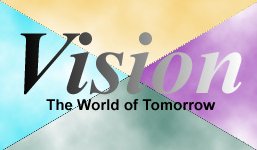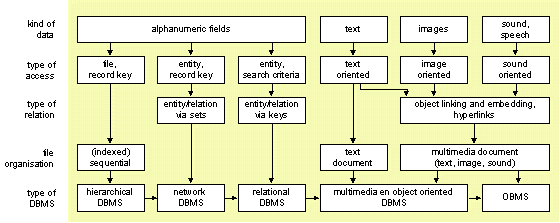
Vision
4.7 Database Management Systems |
Multimedia and object orientation make new requirements of the way data are stored in databases. Currently, most users store documents in separate files instead of in a database management system (DBMS). The current relational database management systems (RDBMS) are suitable for storing alphanumeric fields in the form of tables and keeping them accessible, but they are not really equipped for documents yet. We currently see the development of DBMSs that are suitable for storing multimedia documents. An advantage for the user is the fact that the DBMS offers him better possibilities for retrieval and security of his documents.
Moreover, DBMSs support distributed storage of data and objects in networks increasingly well. This makes it possible for the user to retrieve and edit data and objects on different server computers in a network from his own workstation.

Figure 4.9 Evolution of files and databases. The transition from alphanumeric data to multimedia documents also has consequences for the way in which data are stored in files and databases.
In the sixties, alphanumeric data are initially stored in sequential files. Data are grouped in records - for instance customer data in customer records - and are sorted in the file according to a key, for example customer number or customer name. The sequential files correspond with the tape storage, common in those days.
Then disks are starting to be used for storage, and records are being made directly accessible on key. An example of this is the index-sequential file, in which for instance customer records can be accessed on customer number, via special indexes. Instead of having to read through all the customers, one can now immediately find the right customer by means of the customer number. This corresponds with the transition from batch processing to on-line processing, in which it must be possible to get the customer data directly on the terminal to edit them.
At the beginning of the seventies we see the advent of databases, with hierarchical databases such as IBM's IMS. Subsequently, network databases emerge, such as IDMS, and then relational databases, such as DB2 and Oracle. Currently, relation databases are the common standard.
Relational databases
Data storage in relational databases is based on a data model according to the entity/relationship principle. Entities are for instance 'customer' and 'order'. Between entities, there are relationships. An order always belongs to one customer, whereas there may be several orders to a customer. In a relational databases, each entity is converted into a table with records (called rows). The entity 'customer' becomes a table with a row for each customer. The relationships between the entities are represented by keys. Each order record contains the number of the customer the order belongs to. Relational databases have the advantage that records in a table are not only accessible through a key, but also through other search criteria such as address or place of residence.
Databases can do more than just store and retrieve data. They also handle matters such as:
- authorisation: which users are allowed to retrieve and edit certain data;
- securing data through regular back-up procedures keeping a log of the updates;
- restoring the contents of the database after breakdowns.
Because of these extra facilities we use the name Database Management System (DBMS).
Storage of multimedia documents
With the extensive use of personal computers and multimedia, nowadays, besides structured, alphanumeric data we now also have to store unstructured data such as text, pictures, images and sound. At the present time, most users store this type of data as separate documents, each document being a single file. The user therefore has separate files for each text and each picture. It is also possible to include pictures in a text, but then the picture is copied into the text file. The user also has the option to group the documents in directories or folders.
Accessing multimedia documents
A number of packages for text retrieval software and hypertext are currently available. With this software, the user can improve the access to documents and the relationships between documents. Text retrieval software supports content-based searching for text (so-called full text retrieval). It supports searching texts of different formats and searching on different computers in the network.
Hypertext software can be used to place references and relationships within and between texts. Hypertext supports interactive document navigation. The user can recognise the so-called hyperlinks in documents for instance by a different colour of the words. If the user wants more information about a certain word, he has to point at it with the mouse and click on it. Text relating to that particular word is then automatically shown. From there, the user has the possibility to return to the original text. The documents consist of text and illustrations. Illustrations may be incorporated in the text , or the text may contain references to separately stored illustrations.
Multimedia databases
The next phase is the storage of multimedia documents in relational databases. An example of such a relational database is Oracle Media Server, a relational database in which text, still and moving images and sound can also be stored. There are two advantages to storing documents in the database. The first advantage is that relationships can be made between structured data and documents. The second advantage is that the documents can also use the various security facilities of the DBMS.
Object bases
The database described thus far, only store data. The corresponding applications are separately stored as programmes in files or programme libraries. This has to do with the procedure in which the user first starts an application in the form of programme, and then looks up the data or documents he wants to edit. With the object-oriented approach, it works the other way around. The user first looks up the documents containing the objects he wants to edit, which is then displayed in front of him. To support this way of working, special object-oriented databases are required, in which applications are stored as documents and objects with references to the functions (methods) with which they can be edited.
Suppliers of relational DBMSs, such as Oracle, IBM and Sybase, have begun to extend their DBMSs to support multimedia documents. There will also be object-oriented extensions to make it possible to store data and documents as objects with references to the functions that can be used on these objects. The software is included in the database as functions (methods) of objects, instead of as separate programmes. Eventually, the RDBMS will gradually evolve into an Object base Management System for all types of objects.
Parallel Processing
A number of suppliers have turned to parallel processing to speed up the searching and editing of data in databases. Oracle already has a parallel version for parallel nCube computers, for example. IBM has announced a parallel version of DB2. Parallel processing is ideally suited for the future heavy database servers on which enormous quantities of data are stored.
Distributed databases
All DBMS suppliers are working on or already supply a distributed DBMS in which the data are stored distributed over various computers. The problem with the current distributed DBMSs is the fact that they are based too much on the principle of one large database for all users, where the user does not have to know where data are located or who they belong to. This very 'transparency' of location and organisation, however, is an important reason why the current distributed databases are unsatisfactory in actual practice.
In itself it is true that the user does not need to know where data or objects are physically located, but it is of great importance that the ownership and objects is properly established. This also applies to software such as programmes, packages and object methods.
Now that there is a growth towards a world-wide network in which users (at home and at work) must be able to use each other's data, documents and software, the distributed DBMS must support the legal ownership of these objects. A number of conditions must be met in order to achieve this.
- Each user (private individuals, companies and other organisations) must have his own, personal database with data, objects and software.
- The owner decides which other users have access to the DBMS and which rights they have.
- The DBMS must offer methods for navigation with which the users can search for available data, objects and software.
- The DBMS can also handle the version management of objects.
Summary
When all the conditions are met and the final problems with distribution have been solved, the eventual Digital Highway may contain one world-wide DBMS in which everybody can organise his own database with data, objects and software functions. If parallel processing is used, many users will be able to simultaneously access huge databases. Through publication in the navigation system, one can give others access to ones database and give them the right to copy objects. The DBMS keeps track of the versions of objects. It also keeps track of who is currently using copies and supports the payment of copyright to the owners of objects.